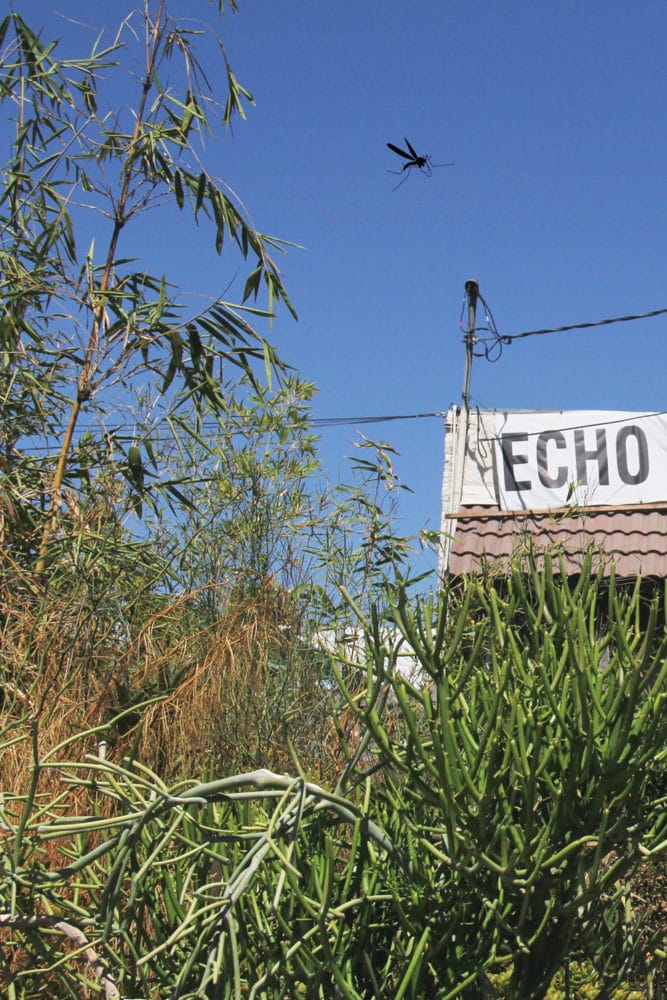
Since 2011, a new mosquito species has caused problems for residents and public health officials in Los Angeles County, according to Kelly Middleton, director of community affairs at the Greater Los Angeles County Vector Control District. While the single native mosquito species in Los Angeles bites birds and small mammals, the invasive mosquito species Aedes aegyptai exclusively bites humans, according to Vector Control District data (another type of Aedes mosquito that has come to LA, Aedes albopticus, bites primarily birds and small mammals, but occasionally humans, as well). Commonly found in the most humid regions of the United States, Aedes aegyptai has made its home in historically dry Southern California.
Public health experts in California first discovered Aedes aegyptai in 2001, according to Middleton.
“When a lot of lucky bamboo plants were being imported into California, we were notified by the port authorities that when they were opening containers for their inspections, all these mosquitoes were flying out,” Middleton said.
Dracaena sanderiana, also known as lucky bamboo, are popular indoor potted plants.
It is the Vector Control District’s responsibility to inspect the original sites of lucky bamboo shipments that contained mosquitoes to track and eliminate the eggs. In response to the mosquitoes being shipped with the lucky bamboo, the Vector Control District worked to eliminate them at the source, according to Middleton.
“We inspected and treated all of the distributors and stores,” Middleton said. “After we went through that process, we did not see any more of these mosquitoes popping up anywhere, until the find in 2011.”
Since 2011, the Aedes aegyptai population has risen, although the cause of the rise is uncertain, according to Middleton.

“We’re not sure if [they] were an isolated population that was allowed to expand and spread, or whether it was continued introductions from the original source in Southeast Asia,” Middleton said.
According to Middleton, the Vector Control District has encountered some issues unique to this species of mosquito. Primarily, Middleton mentioned that the human-exclusive bite of the Aedes aegyptai makes them very serious vectors of disease.
Their bite is not the only trait which makes the Aedes aegyptai a community pest.
“With these new types of mosquitoes, they actually thrive more in urban areas,” Middleton said. “So we find them densely populated in neighborhoods. Right now, we are kind of nearing the peak of their populations for the summer, and we’re getting calls from all over the place that people are getting just eaten alive by these mosquitoes.”
Amanda Zellmer, assistant professor of biology at Occidental, explained why these mosquitoes are forgoing more humid areas for the urban neighborhoods of Southern California.
“Even though the general habitat isn’t very humid, there is a lot of change within the city of LA,” Zellmer said. “People are irrigating their lawns, leaving swimming pools that are not taken care of, it’s just a big body of water where mosquitoes can lay their eggs.”
Despite the uncertain origin of Aedes aegyptai, the Vector Control District maintains extensive measures to investigate the origin of the populations nesting in neighborhoods all over Los Angeles County.
“We monitor a lot of the nursery sites. We also go to the distributors of these plants,” Middleton said. “As far as the plant resellers we have in our district, we monitor all of them.”
One such reseller in Eagle Rock, Hi Duk Lee, has owned and operated the Echo Garden plant nursery for eight years.
“The Department of Public Health is in here almost every week to check the plants,” Lee said. “They check saucers, planters — they are checking the water.”
At the mention of mosquitoes, Lee pointed to a spiral-shaped incense burning on the ground, called a mosquito coil. He had placed them all over his shop. Lee recommends this item to individuals dealing with mosquitoes at home.
“[Smoke] works best,” Lee said. “[These coils] are from Japan.”
What does not work to deter mosquitoes, according to Lee, are traditional insecticides.
Lee pointed towards some insecticide spray bottles.
“We’re using this one. It never works,” Lee said. “[It is intended to kill] mosquitoes, all insects, but it doesn’t work.”
Middleton also noted the failures of pesticide.
“Pesticides are a very short-lived solution,” Middleton said. “Invasive Aedes control is far more about controlling the water sources that they are hatching out of.”
Most often, Aedes mosquitoes nest in suburban backyards. Community members should pay more attention to their yards if they want to curb the mosquitoes, Middleton said.
“If they spend an hour or two walking around and checking their yards and their neighbors’ yards, and they get rid of those buckets or those rain barrels, empty the water out of them, scrub out the containers, get rid of the saucers under their potted plants, those things will eliminate the mosquito problem,” Middleton said.
In other parts of the world, Aedes aegyptai are known to spread disease like the Dengue virus, according to the Center for Disease Control.
According to Zellmer, this is not something community members in Southern California should worry about.
“As of right now, I don’t think it [disease outbreak] is very likely … because of the lack of connectivity with the more southern populations of this species,” Zellmer said. “But it is a possibility, especially if there was an outbreak of any of those diseases in the region. I could only see that happening if somebody was traveling here with those diseases, and I just don’t think it’s very likely for that to happen right now.”
Disease is highly unlikely, yet the populations of aegyptai mosquitoes peak at this time of year, and their human-exclusive bite is difficult to ignore, according to Middleton. Despite low risk of disease, Middleton said that Aedes aegyptai remain problematic.
“They’re really very difficult to live with. It’s just about prevention,” Middleton said.
![]()



































